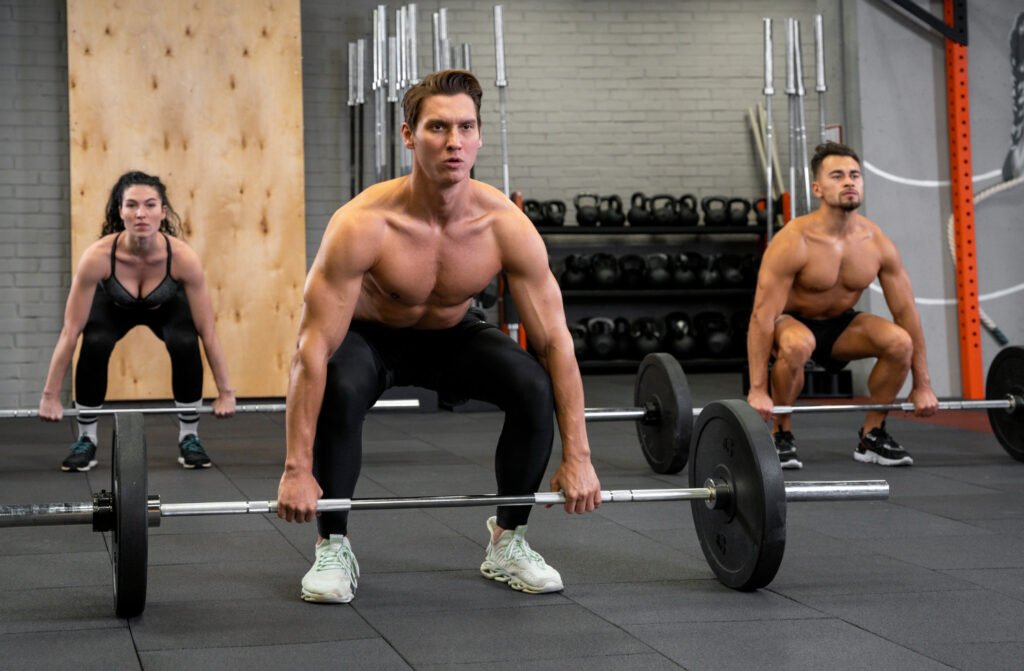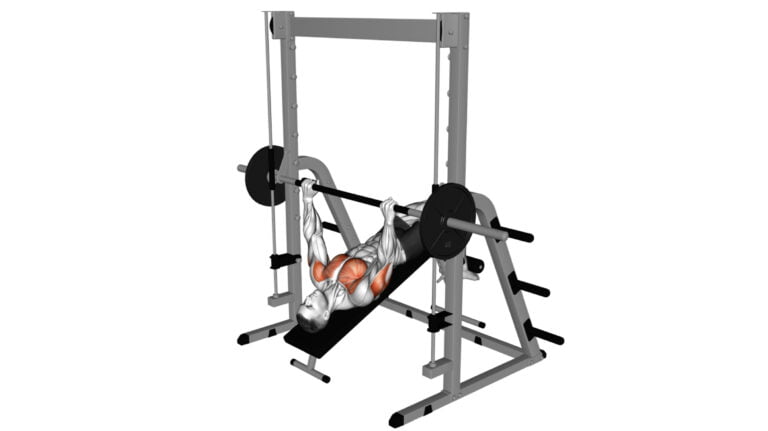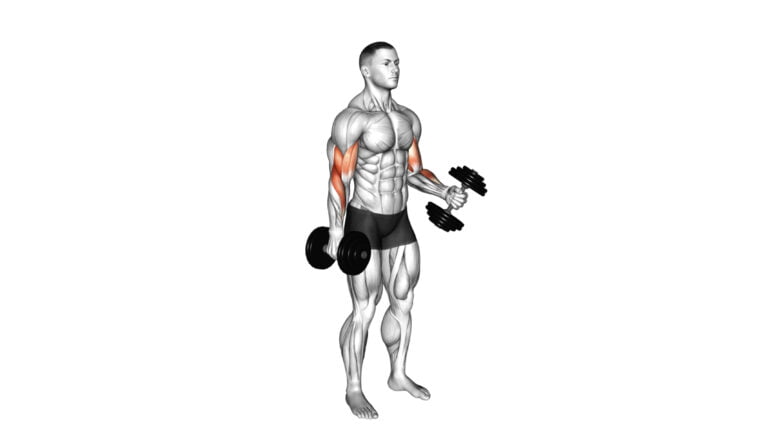Best 10 Barbell Exercises for Lower Back

Strengthening your lower back is crucial, yet many don’t realize its importance until they face discomfort or injury. With a background in fitness training and years of experience, I’ve observed firsthand how the right exercises can transform one’s back health and overall well-being.
Barbell exercises for lower back focus precisely on building strength where it counts, helping to prevent common issues before they start.
The foundation of any strong physique includes a sturdy lower back; it supports almost every movement and posture throughout the day. This article dives into 10 essential barbell exercises that target not just the muscles of the lower back but also those around it for balanced development.

Understanding these will equip you with knowledge to fortify your body against strains, thus enhancing daily performance and long-term health. Stay tuned – this insight could be a game-changer for your routine!
Key Takeaways
- Performing barbell exercises like Clean Deadlifts, Curtsey Lunges, and Straight Leg Deadlifts can significantly strengthen your lower back, supporting spine health and improving posture.
- Proper form during these exercises is essential to prevent injuries. Engaging your core, keeping a straight back, and focusing on controlled movements help maximize benefits while minimizing risks.
- Incorporating core training alongside barbell workouts enhances stability and strength in the lower back. Exercises such as planks and Russian twists support this goal by building a stronger core foundation.
- Warming up with dynamic stretches before starting a barbell routine prepares your muscles for exercise, reducing the likelihood of strain or injury.
- Consistency in performing these recommended sets and reps of barbell exercises contributes to overall lower body strength, making daily activities easier and improving athletic performance.
Importance of Strengthening Your Lower Back

Strengthening your lower back is crucial for overall strength and stability. It helps in maintaining good posture, prevents injuries, and supports the entire body during physical activities.
Benefits of a strong lower back
A strong lower back enhances your overall strength and stability, enabling you to perform a wide range of exercises more effectively. It supports the spinal column, helping to maintain good posture and reducing the risk of lower back pain.
This foundational strength is crucial for both daily activities and intense workouts, including barbell exercises like deadlifts and squats.
Building power in this area also improves your balance and flexibility, making it easier to move freely without strain. A robust lower back can bear greater loads during weight training, protecting against injuries that could sideline your fitness goals.
Next up, we’ll explore how preventing injuries is directly linked to these benefits.
Preventing injuries
Preventing injuries during strength training, especially when using barbells for lower back exercises, demands strict attention to form. Proper lifting techniques keep the spine aligned and reduce stress on the lumbar spine.
For instance, engaging your core stabilizes the lower back, while maintaining a slight bend in the knees can protect your hamstrings and glutes during lifts like conventional deadlifts and Romanian deadlifts.
Focus on mastering the movement patterns before increasing weight to ensure muscles work effectively without straining. Warm up thoroughly with dynamic stretches targeting the erector spinae muscles, hips, and shoulders to enhance flexibility and preparedness for exercises like squats and deadlifting.
Incorporating exercises that strengthen the transverse abdominis also plays a crucial role in supporting your lumbar spine during heavy lifts.
10 Essential Barbell Exercises for Lower Back

Strengthen your lower back with these ten essential barbell exercises, targeting key muscles for support and stability. Incorporate these movements into your workout routine for a strong and resilient lower back.
1. Barbell Clean Deadlift
The Barbell Clean Deadlift is a powerful compound exercise that targets your lower back, along with your latissimus dorsi and glutes. You begin in a squatting position, gripping the barbell with both hands slightly wider than shoulder-width apart.
With your feet planted firmly on the ground and your spine in a neutral position, you lift the barbell by extending your legs and hips, then pulling the weight up towards your shoulders in one smooth motion.
This move not only strengthens major muscle groups but also improves your posture and boosts overall muscular coordination.
Executing this exercise requires focus on form to avoid injury. Keep your elbows pointed outwards as you lift, and make sure to engage your core throughout the movement. As you become more proficient, adding this lift into your routine can significantly enhance power for other lifts and athletic performance.
Moving on, let’s explore how incorporating Barbell Curtsey Lunges can further strengthen and stabilize lower back muscles.
2. Barbell Curtsey Lunge
Transitioning from the Barbell Clean Deadlift, the Barbell Curtsey Lunge is a dynamic exercise that targets multiple muscle groups in the lower body. To perform this exercise, stand tall with a barbell across your upper back.
Step one foot behind and to the side of the other, bending both knees as if performing a curtsy. Push through your front heel to return to standing position and repeat on the other side.
This compound movement engages the glutes, quadriceps, hamstrings, and adductors while also challenging balance and stability. The Barbell Curtsey Lunge helps develop functional strength for everyday movements and sports performance while promoting hip mobility and core stability.
3. Barbell Low Split Squat
Transitioning from the Barbell Curtsey Lunge, another crucial barbell exercise for strengthening your lower back is the Barbell Low Split Squat. This compound movement targets the glutes, hamstrings, quadriceps, and also engages the core for stability.
To perform this exercise, start in a split stance with one foot forward and one foot back. Place a barbell on your shoulders and lower your body until both knees are bent at 90-degree angles.
Push through your front heel to return to the starting position.
4. Barbell Lateral Lunge
The barbell lateral lunge is a great exercise for targeting the inner and outer thighs, glutes, and quadriceps. Start by standing with your feet hip-width apart, holding onto a barbell across your shoulders.
Take a wide step to the side, bending one knee while keeping the other leg straight. Push back up to the starting position using the heel of your bent leg. This move helps improve lower body strength and stability while engaging key muscle groups.
When performing this exercise, focus on keeping your chest lifted and maintaining good posture throughout the movement. Keep in mind that proper form is essential for avoiding strain or injury to your lower back and knees.
5. Barbell Lunge Twist
To perform the barbell lunge twist, stand with your feet shoulder-width apart and hold a barbell across your upper back. Step forward into a lunge position, ensuring that both knees are at 90-degree angles.
As you lower into the lunge, rotate your torso to the same side as your front leg. Return to the starting position and repeat on the other side.
This exercise engages the core, glutes, quadriceps, and obliques while enhancing stability and coordination. It also promotes thoracic spine mobility and improves rotational strength in the lower body.
6. Barbell One Arm Side Deadlift
The barbell one arm side deadlift targets the lower back, glutes, hamstrings, and obliques. Hold a barbell in one hand with an overhand grip and stand with your feet shoulder-width apart.
Slowly lower the weight towards the outside of your foot while keeping your back straight. Engage your core as you return to standing position. This exercise helps improve unilateral strength and stability.
Moving on to the next essential barbell exercise for strengthening your lower back – 7. Barbell Pin Good Morning.
7. Barbell Pin Good Morning
To perform a Barbell Pin Good Morning, start by setting an adjustable bench in a flat position and place it inside the squat rack. Position the barbell across your upper back, below the trapezius muscles, leaning against the J-hooks with your feet shoulder-width apart.
Keep your chest up and out and maintain a slight bend in the knees while hinging at the hips to lower your torso forward until you feel a stretch in your hamstrings. Slowly return to the starting position by driving through the heels while keeping your back straight throughout.
This exercise effectively targets the hamstrings, glutes, lower back, and core muscles. It helps improve hip mobility and increases strength in those muscle groups necessary for overall functional movement and athletic performance.
8. Barbell Snatch Deadlift
The barbell snatch deadlift is a compound exercise that targets multiple muscle groups, including the lats, rear delts, and shoulders. It involves lifting the bar from the ground to an overhead position in one explosive movement.
To perform this exercise, stand with your feet shoulder-width apart and grasp the bar with an overhand grip. Keep your back straight as you lift the bar off the floor using a powerful hip drive and then extend through your hips and knees to pull the bar upward.
As it reaches chest height, swiftly drop underneath it into a quarter squat position while simultaneously pressing the weight upwards until your arms are fully extended overhead.
This dynamic movement engages several key areas of the body simultaneously, making it an efficient addition to any lower back strengthening routine. The coordination required for this exercise also helps improve overall athleticism and power.
Ensure proper form by keeping your core engaged throughout each repetition to support your lower back and prevent injury.
9. Barbell Straight Leg Deadlift
To perform the barbell straight leg deadlift, stand with feet hip-width apart and grasp the bar using an overhand grip. Keep your back straight and push your hips back as you lower the bar toward the ground, feeling a stretch in your hamstrings.
Engage your glutes to return to standing position. This exercise targets the hamstrings, glutes, lower back, and core while improving hip hinge movement.
The barbell straight leg deadlift strengthens muscles essential for maintaining proper posture and preventing lower back pain. Incorporate it into your routine for overall lower body strength and stability.
10. Barbell Single Leg Good Morning
The barbell single leg good morning strengthens the lower back, glutes, and hamstrings. To perform, stand with feet hip-width apart, holding a barbell across your upper back. Lift one foot off the ground and hinge forward at the hips while keeping your back flat.
Lower until you feel a stretch in your supporting hamstring, then return to standing position. This exercise improves balance, stability, and targets each leg individually.
For added difficulty and effectiveness in strengthening the lower back muscles, increase resistance gradually by adding weight or adjusting repetitions. Remember to maintain proper form throughout to avoid potential injury and maximize gains from this powerful exercise.
Recommended Sets And Reps
Transitioning from the Barbell Single Leg Good Morning to Recommended Sets And Reps, here are the recommended sets and reps for strengthening your lower back with these essential barbell exercises.
Aim for 3 to 4 sets of 8 to 12 reps for each exercise. Ensure proper form and technique throughout each set to maximize the benefits while minimizing the risk of injury.
The key is to start with a weight that challenges you but allows you to complete all repetitions with good form. As you progress, gradually increase the weight while maintaining proper form and control.
Recommended Barbell Back Workout

For strengthening the lower back, a recommended barbell back workout includes focusing on compound exercises that engage multiple muscle groups. This can help in developing overall strength and stability in the lower back while avoiding overexertion.
Warm-up exercises
Performing warm-up exercises is essential before engaging in any barbell lower back workout. Start with 5-10 minutes of light cardiovascular exercise, such as brisk walking or cycling, to increase blood flow and raise body temperature.
Follow this with dynamic stretches targeting the lower back muscles, including leg swings and torso twists. Incorporate bodyweight movements like hip hinges and gentle back extensions to activate the muscles without causing strain.
Gradually increase the intensity of these warm-up activities to prepare your lower back for the upcoming barbell exercises.
Sample workout routine
Perform the following sample workout routine to strengthen your lower back. Start with three sets of Barbell Clean Deadlifts, aiming for 8-10 reps per set. Then, move on to three sets of Barbell Low Split Squats, performing 10-12 reps in each set.
Follow this with four sets of Barbell Pin Good Mornings for 6-8 reps per set. Finish the routine with two sets of Barbell Straight Leg Deadlifts, striving for 12-15 reps in each set.
Ensure proper form and technique throughout the workout to maximize the benefits and minimize the risk of injury.
Tips for Avoiding Pain when Training Your Lower Back

Maintain proper form by keeping your chest up and back straight during barbell exercises for lower back. Engage your core muscles to support your lower back while training with barbell exercises.
Proper form
Maintain a straight back and engage your core muscles during each barbell exercise. Keep your shoulders relaxed and retracted to avoid unnecessary tension in the upper body. Ensure that your feet are planted firmly on the ground for stability and proper weight distribution.
Remember to keep your neck in a neutral position, avoiding any strain or hyperextension. As you perform each movement, focus on controlled and deliberate motions to maximize the benefit of the exercise.
Now, let’s explore some tips for incorporating core training into your barbell workout routine.
Incorporating core training
To complement proper form, incorporating core training into your workout routine is crucial for strengthening the lower back. Engaging the abdominal muscles and lower back during exercises like planks, Russian twists, and mountain climbers can help stabilize the spine and improve overall strength.
Additionally, including compound movements such as weighted squats and deadlifts helps to activate multiple muscle groups in the core, further enhancing stability and support for the lower back.
By integrating these exercises into your training regimen, you can build a solid foundation of core strength to protect your lower back from injuries while performing barbell workouts.
Conclusion

Strengthening your lower back is crucial for preventing injuries and enjoying the benefits of a strong lower back. These 10 essential barbell exercises for lower back offer practical and efficient ways to build strength.
Implementing these strategies can lead to significant improvements in your overall fitness and well-being. Consider exploring additional resources or seeking guidance from fitness professionals as you incorporate these exercises into your routine.
Take action now to prioritize the health and strength of your lower back, empowering yourself to reach new levels of physical vitality and resilience.
FAQs
1. What are barbell exercises good for strengthening the lower back?
Barbell exercises like the deadlift, sumo deadlift, and back squat work great for strengthening your lower back by targeting muscles around your spine and abdomen.
2. How do I perform a barbell row correctly?
To do a barbell row, keep your backbone straight, bend slightly at the knees, and pull the bar towards your abdomen. Make sure to squeeze your shoulder blades together as you lift.
3. Can doing squats help my lower back?
Yes! Squats, especially deep squats with free weights like a barbell or kettlebells, strengthen not just your legs but also improve muscle support around your lower back.
4. Why is it important to avoid improper lifting techniques?
Using improper lifting techniques can lead to injuries because it puts too much strain on specific parts of your body such as the lumbar region in your lower back instead of distributing weight evenly.
5. Do rear delt rows benefit my lower back?
Rear delt rows mainly target upper arm and shoulder blade muscles but also engage core stabilizers including those supporting the lower back when performed correctly.
6. Are there isolation exercises for the muscles in my lower back?
Exercises like hyperextensions focus specifically on strengthening extensor muscles along the spine without involving other major muscle groups, making them effective isolation exercises for improving low-back strength.

Author
Years ago, the spark of my life’s passion ignited in my mind the moment I stepped into the local gym for the first time. The inaugural bead of perspiration, the initial endeavor, the very first surge of endorphins, and a sense of pride that washed over me post-workout marked the beginning of my deep-seated interest in strength sports, fitness, and sports nutrition. This very curiosity blossomed rapidly into a profound fascination, propelling me to earn a Master’s degree in Physical Education from the Academy of Physical Education in Krakow, followed by a Sports Manager diploma from the Jagiellonian University. My journey of growth led me to gain more specialized qualifications, such as being a certified personal trainer with a focus on sports dietetics, a lifeguard, and an instructor for wellness and corrective gymnastics. Theoretical knowledge paired seamlessly with practical experience, reinforcing my belief that the transformation of individuals under my guidance was also a reflection of my personal growth. This belief holds true even today. Each day, I strive to push the boundaries and explore new realms. These realms gently elevate me to greater heights. The unique combination of passion for my field and the continuous quest for growth fuels my drive to break new ground.















